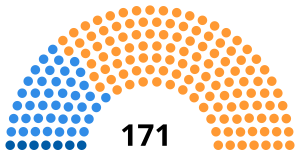1974 South African general election
| ||||||||||||||||||||||
All 171 seats in the House of Assembly | ||||||||||||||||||||||
|---|---|---|---|---|---|---|---|---|---|---|---|---|---|---|---|---|---|---|---|---|---|---|
| ||||||||||||||||||||||
 House of Assembly after the election | ||||||||||||||||||||||
| ||||||||||||||||||||||
| This article is part of a series on the |
| Politics of South Africa |
|---|
 |
|
|
The 1974 South African general election, held on 24 April, was called one year earlier than scheduled by Prime Minister John Vorster on 4 February. The House of Assembly was increased from 166 to 171 members. The Progressive Party made a major advance. In addition to Helen Suzman, re-elected for Houghton, five other members won seats including the party leader Colin Eglin. A seventh member of the caucus was elected at a by-election soon after. The United Party won 41 seats. The election would also see Harry Schwarz, leader of the United Party in the Transvaal, enter Parliament, who would soon lead a break away from the United Party and would become one of the Apartheid's most prominent opponents in Parliament.
Formation of Reform Party
On 11 February 1975 four liberal MPs led by Harry Schwarz broke away from the United Party and created the Reform Party. The party merged with the Progressive Party on 25 July 1975 to form the Progressive Reform Party. In 1977 another group of United Party members left the party to form the Committee for a United Opposition, which then joined the Progressive Reform Party to form the Progressive Federal Party. This proved to realign the opposition in Parliament, as the PFP became the official opposition party.
Nominations
Nominations closed on 18 March. A total of 334 candidates were nominated for 171 seats: National Party 137, United Party 110, Herstigte Nasionale Party 46, Progressive Party 23, Democratic Party 7 and others 11.[1] 46 seats were won unopposed, 32 for the National Party and 14 for the United Party.
House of Assembly results
125 of the 171 seats were contested. There were 2 203 349 registered voters. [2]
| Party | Leader | Candidates | Votes | %Votes | Seats | %Seats | Previous | Change | |
|---|---|---|---|---|---|---|---|---|---|
| National Party | John Vorster | 105 | 636 586 | 57.1% | 123 | 71.9% | 118 | +5 | |
| United Party | De Villiers Graaff | 96 | 363 459 | 32.7% | 41 | 24.0% | 47 | -6 | |
| Progressive Party | Colin Eglin | 22 | 58 768 | 5.3% | 7 | 4.1% | 1 | +6 | |
| Herstigte Nasionale Party | Albert Hertzog | 48 | 39 568 | 3.6% | 0.0% | 0 | |||
| Democratic Party | Theo Gerdener | 7 | 10 449 | 0.9% | 0.0% | 0 | |||
| Others | 15 | 4 990 | 0.4% | 0.0% | 0 | ||||
| Total valid | 293 | 1 113 820 | 100.0% | 171 | 100.0% | 166 | +5 | ||
| Spoilt | 20 823 | ||||||||
| Total votes | 1 134 643 | ||||||||
Senate
The elections for the Senate were held on 30 May 1974 by an electoral college made up of members of the Assembly and various others. The National Party gained one seat at the expense of the United Party, winning 32 of the 44 seats (the United Party held 12 seats).
| Seats | |||
|---|---|---|---|
| National Party | 32 | +1 | |
| United Party | 12 | —1 | |
| Total | 44 | ||
Sources


